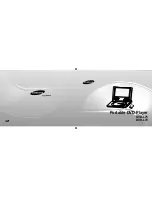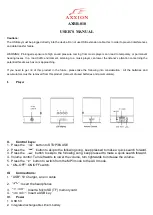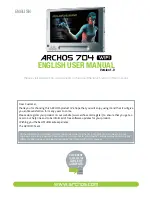
©Copyright AMKUS Rescue Systems 2020-2021
5
LAP-012 October 7, 2021 Rev02
1.0 MEANING OF SAFETY SIGNAL WORDS
A safety related message is identified by a safety alert symbol and a signal word to indicate the level of risk involved with a particular
hazard. Per ANSI Z535.6, the definitions of the four signal words are as follows:
2.0 SAFETY
DANGER
DANGER indicates a hazardous situation which, if not avoided, will result in death or serious injury.
WARNING
WARNING indicates a hazardous situation which, if not avoided, could result in death or serious
injury.
CAUTION
CAUTION indicates a potentially hazardous situation which, if not avoided, could result in minor
or moderate injury.
NOTICE
NOTICE is used to address practices not related to physical injury.
WARNING
When using electric motorized equipment, basic safety precautions should always be followed
to reduce the risk of fire, electric shock, injury, or death.
• Circuit breakers matched to the motor capacity are required. Don’t operate electric motors
without circuit breaker protection.
• Always use a cord heavy enough to carry the current the tool will draw. Use of an undersized
cord will cause a drop in line voltage resulting in loss of power and overheating.
• Power cord type must be rated for outdoor use, such as SW, SOW, STW, STOW, SJW, SJOW,
SJTW, or SJTOW. (W service rating = outdoor and wet location).
• Ensure the power cord is in good condition before use. Never lift or pull the equipment by the
cord or yank it to disconnect from receptacle. Keep cord from heat, oil, crushing, and sharp
edges. Inspect cords for damage after each use. Replace damaged cords before placing
equipment in service.
• Disconnect the equipment from the power supply when not in use, before cleaning, inspecting,
or servicing electric motors and controls.
• Keep covers and guards in place and in working order.
WARNING
Using rescue tools can cause ignition or explosion resulting in injury or death. Ignition or explosion
can result from situations such as:
• Flammable hazards are created when fuel lines, refrigerant lines (atomized oil), or pressurized
hydraulic fluid lines are breached. Ignition sources can suddenly ignite these fuels.
• Flammable vapors can be released by careless refueling or operation of gasoline driven
engines. Refer to engine manufacturer’s manuals for specific details.
• Extrication tools can create sparks as metals are cut and deformed. Avoid unnecessary risk
when flammable vapors are present.
• Power units with electric motors or internal combustion engines are ignition sources.
Flammable vapors heavier than air can accumulate in low spots. Avoid selecting these locations
when setting up the power units. Use detectors to verify safe site selection.
WARNING
Hydraulic fluid (mineral oil) escaping under pressure can puncture the skin, infiltrate eyes, or lungs
resulting in serious injury. Seek medical attention immediately. Avoid the urge to contain leaks with
hands. Injection injuries require immediate medical attention. Safety Data Sheet (SDS) for AMKUS
MV1 and AMKUS MV0 Hydraulic Fluid is available at AMKUS.com and CHEMTREC.com
Hydraulic leaks can occur from situations such as:
• Leaks at hose crimps and connections can develop from constant use, over-pressurization,
side-loading, or mis-crimping.
• Hose damage from being driven over, stepped on, twisted, kinked, crushed, excessive vibration,
abuse, or neglect.
• Leaks and breaks in hydraulic components can occur from improper maintenance or exceeding
service life expectations. Establish sound practices.
• Connecting hydraulic tools in series can pressurize both sides of double acting cylinders. Each
tool must be separately connected to a power unit.
• Release stored pressure before servicing tools by moving off end stops. Refer to power unit
manuals for proper operation.






































